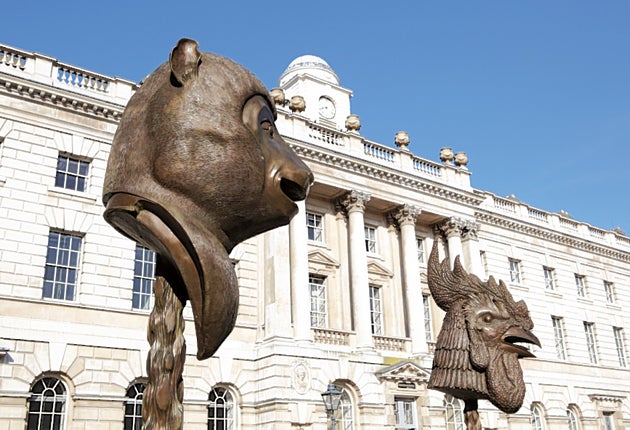Ai Weiwei, Somerset House/Lisson Gallery, London

Your support helps us to tell the story
From reproductive rights to climate change to Big Tech, The Independent is on the ground when the story is developing. Whether it's investigating the financials of Elon Musk's pro-Trump PAC or producing our latest documentary, 'The A Word', which shines a light on the American women fighting for reproductive rights, we know how important it is to parse out the facts from the messaging.
At such a critical moment in US history, we need reporters on the ground. Your donation allows us to keep sending journalists to speak to both sides of the story.
The Independent is trusted by Americans across the entire political spectrum. And unlike many other quality news outlets, we choose not to lock Americans out of our reporting and analysis with paywalls. We believe quality journalism should be available to everyone, paid for by those who can afford it.
Your support makes all the difference.Ai Weiwei, the most important contemporary Chinese artist and political activist of his generation, has been missing since he was detained by authorities in Beijing while boarding a flight to Hong Kong on 3 April, and has not been seen or heard of since. And so, he has been missing from the openings of two exhibitions of his work opening in London this week.
For Somerset House, Ai has created 12 huge monumental bronze animal heads, Circle of Animals/ Zodiac Heads, which are currently on a world tour. These pigs, dogs, rabbits and snakes are based on the heads that once adorned the fountain-clock of Yuanming Yuan. In 1860, the imperial resort was ransacked by French and British troops, and the heads were pillaged. Today, seven heads have been retrieved (the late Yves Saint Laurent owned the rabbit and the rat heads, a controversy that raised its head when his collection was auctioned in 2008 and the Chinese foreign ministry demanded that they be returned), although the dragon, the snake, the sheep, the cock and the dog remain missing. Using simple, enjoyable means, the artist raises issues of authenticity and the selling of culture abroad, though the sculpture now seems haunted by the idea that five of the animals were kidnapped, and remain missing.
Across the two spaces of the Lisson Gallery are a selection of the artist's works from the past 10 years or so, including a bent coffin and benches made from wood taken from dismantled temples of the Qing dynasty, and four imposing wooden chests with circular holes in them that create the experience of watching different phases of the moon. The loveliest, and yet, the most uncomfortable of the works here, are collections of Han dynasty (206BC-220AD) vases that Ai has painted in bright splashy shades of industrial paint. It's clear that these might have been protected, someone might have stopped the artist just painting over history. But really, he seems to say, who has a choice, here, in what is done to them? In what is hidden, what is covered up, sold or destroyed? It's a gesture of protest. As the artist said recently: "It's impossible to stop freedom. It's just like a wind. How could you stop it?" What's left to say, but free Ai Weiwei?
Somerset House (020 7845 4600) to 26 June; Lisson Gallery (020 7724 2739) to 16 July
Join our commenting forum
Join thought-provoking conversations, follow other Independent readers and see their replies
Comments